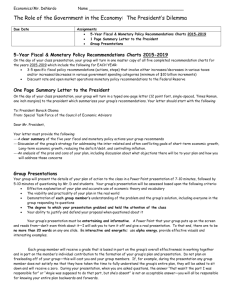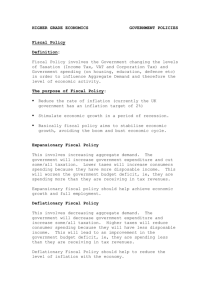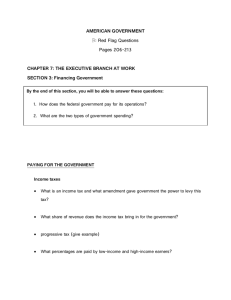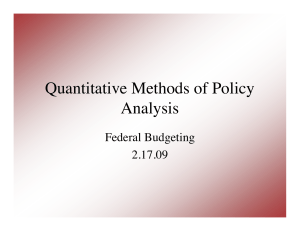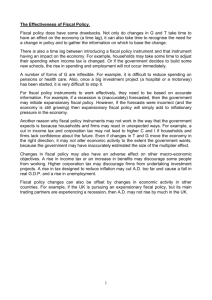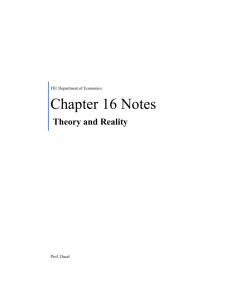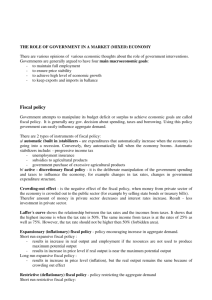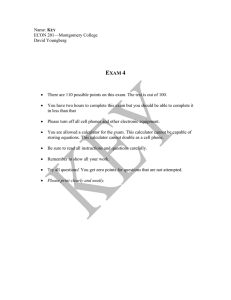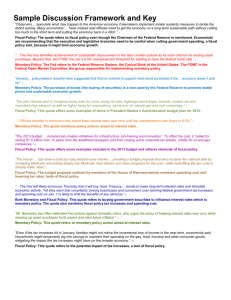American Government and Politics Today
advertisement
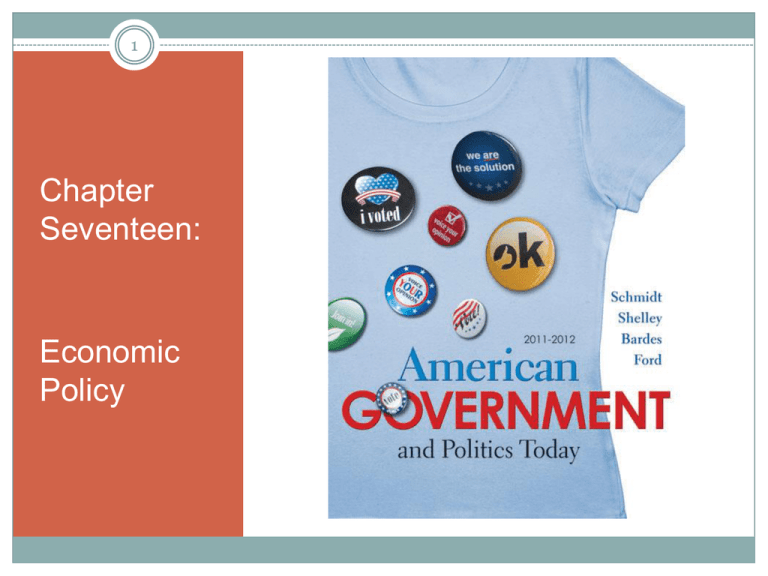
1 Chapter Seventeen: Economic Policy Learning Objectives 2 Define and use correctly a series of basic terms used in discussions of economic policy, including inflation, unemployment, the business cycle, recession, depression, and budget deficit. Explain the essential tools of fiscal policy, namely increasing the budget deficit during a recession and reducing it during a boom. Learning Objectives 3 Describe how the Federal Reserve System implements monetary policy (increasing or decreasing the rate of growth of the money supply). Explain why fiscal policy may be more effective against recessions and monetary policy against inflation. Learning Objectives 4 Identify some of the important events in the history of economic policy since World War II, including: Kennedy’s use of Keynesianism, Triggering of inflation under Johnson, Volker’s suppression of inflation, Bill Clinton’s tax increase, George W. Bush’s return to budget deficits, Unique challenges presented by the sustained 2008 recession. Learning Objectives 5 Define key concepts used in the discussion of world trade, including imports, exports, quotas, and tariffs. Understand some of the arguments economists advance in favor of free trade. Describe the role of the World Trade Organization (WTO). Understand the concept of a marginal tax rate. Learning Objectives 6 Define progressive and regressive taxes and identify which taxes fall into each category. Understand the pay-as-you-go character of Social Security and why an aging population presents problems for the long-term health of Social Security. Evaluate some of the proposals that have been advanced to guarantee the survival of the Social Security system in the future. Good Times, Bad Times 7 Good times are called economic booms, while economic slowdowns are called recessions. Unemployment Inflation The Business Cycle Good Times, Bad Times 8 Good Times, Bad Times 9 Good Times, Bad Times 10 Fiscal Policy 11 The President and Congress control fiscal policy—taxing and spending. Keynesian Economics: Government Spending Government Borrowing Discretionary Fiscal Policy Fiscal Policy 12 Deficit Spending and Public Debt The government funds its deficit primarily by selling U.S. Treasury bonds. Thirty years ago, only 15 percent of these bonds were held abroad. Today the figure is 50 percent. Fiscal Policy 13 The Public Debt in Perspective: Net Public Debt Gross Domestic Product (GDP) Are We Always in Debt? Fiscal Policy 14 Fiscal Policy 15 Monetary Policy 16 Organization of the Federal Reserve System The Fed implements policy by increasing or reducing the rate of growth of the money supply. Loose monetary policy increases supply of credit. Tight monetary policy decreases the supply of credit. Monetary Policy 17 Monetary policy has a problem with time lags, but the Fed can make a policy change more quickly than Congress. The Fed announces changes to monetary policy by raising or lowering the federal funds rate. World Trade 18 Imports and Exports The Impact of Import Restrictions on Exports Protecting American Jobs Quotas and Tariffs Free Trade Areas and Common Markets World Trade 19 The World Trade Organization The WTO seeks to lower trade barriers worldwide by administering trade agreements, acting as a forum for trade negotiations, settling trade disputes, and reviewing national trade policies. The WTO has become the focus of those who fear the supposed dangers of globalization. Neither the United States nor any other country has a veto power within the WTO. World Trade 20 Balance of Trade and Current Account Balance Balance of trade: the U.S. balance of trade has been significantly negative for many years. Current account balance: includes the balance of trade in services, unilateral transfers, and other items. Are we borrowing too much from other countries? World Trade 21 Politics of Taxes 22 Currently, Americans’ taxes are about 30% of the GDP. Federal Income Tax Rates: Loopholes and Lowered Taxes Progressive and Regressive Taxation Politics of Taxes 23 Who Pays? Liberals tend to favor progressive taxes. Conservatives either favor taxes that are less progressive or even flat or regressive. Politics of Taxes 24 Politics of Taxes 25 Politics of Taxes 26 The Social Security Problem 27 Social Security was established as a means of guaranteeing a minimum level of pension benefits to all persons. Social Security is not a pension fund; it is a pay-as-you-go transfer system in which those who are working are paying benefits to those who are retired. Workers Per Retiree: Today there are only about three workers paying for each retiree. The Social Security Problem 28 The Social Security Problem 29 What Will It Take to Salvage Social Security? Proposed Policy Options: Raise Taxes Increase the age of eligibility for benefits Increase immigration Privatize Social Security Web Links 30 Tax Foundation: educates taxpayers about sound tax policy and the size of tax burden borne by Americans at all levels of government. See www.taxfoundation.org. World Trade Organization: deals with the rules of trade between nations at a global or nearglobal level providing a set of rules and a negotiating forum. See www.wto.org. What If…The Federal Government Were Required to Balance Its Budget? 31 Except for the wartime periods of the Civil War and World War II, the U. S. government budget normally ran a very low deficit. Possible ways to balance the budget: raise taxes reduce spending by federal government What If…The Federal Government Were Required to Balance Its Budget? 32 Middle class families’ taxes would be rise significantly. Corporate taxes would increase. What If…The Federal Government Were Required to Balance Its Budget? 33 Spending would also be cut: Fewer pork barrel projects Drastic cut in entitlement programs Fewer U.S. Treasury bonds would be held by foreign residents and governments. You Can Make a Difference: How to Plan For Your Future 34 College graduates today could live to be 100 years old, and must plan and save for a long retirement. A comfortable retirement based on a “threelegged stool” of Social Security, pensions, and savings may not be there for today’s college students. College graduates should start saving and investing right away. You Can Make a Difference: How to Plan For Your Future 35 Ask potential employers: Is there a traditional benefit pension plan? Is there a 401(k) or other contribution plan? How soon can you join the plan? What are the plan’s vesting rules, and what happens to your money if you leave the company? You Can Make a Difference: How to Plan For Your Future 36 Choose to Save is a program of the nonprofit Employee Benefit Research Institute and the American Savings Education Council, and provides free savings tools and information to help plan for financial security. Go to www.choosetosave.org.
